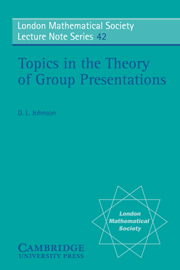Book contents
- Frontmatter
- Contents
- Preface
- Chapter I Free groups and free presentations
- Chapter II Examples of presentations
- Chapter III Groups with few relations
- Chapter IV Presentations of subgroups
- Chapter V The triangle groups
- Chapter VI Extensions of groups
- Chapter VII Small cancellation groups
- Chapter VIII Groups from topology
- Guide to the literature and references
- Index of notation
- Index
Chapter I - Free groups and free presentations
Published online by Cambridge University Press: 28 January 2010
- Frontmatter
- Contents
- Preface
- Chapter I Free groups and free presentations
- Chapter II Examples of presentations
- Chapter III Groups with few relations
- Chapter IV Presentations of subgroups
- Chapter V The triangle groups
- Chapter VI Extensions of groups
- Chapter VII Small cancellation groups
- Chapter VIII Groups from topology
- Guide to the literature and references
- Index of notation
- Index
Summary
The words are all there ready; now we've got to get them in the right order.
(Python)A group G is generated by a subset X if each of its elements can be expressed as a product of members of X±1. Such a product is called a word, and a relation is an equation between two words. A set R of relations that hold in G defines the group if every relation that holds in G is a consequence of R. When this happens, we say that G is presented by X and R. This definition is made rigorous using the concept of a free group (essentially, a group having a set of generators between which there are no non-trivial relations), which is defined using a universal property. Having developed some elementary but important properties of free groups (such as their existence), we proceed to the fundamental theorem of §2, where Schreier's proof is given in detail and Nielsen's original method in outline. In §3, the definition of group presentation is made rigorous, and this is used to clarify the proof of the Nielsen-Schreier theorem by means of an anotated example. §4 explains how to pass from a group multiplication table to a presentation and from one presentation to another, as well as describing a presentation for a direct product of two groups.
Elementary properties of free groups
The fundamental notion used in defining presentations of groups is that of a free group. As the definition suggests, the idea of freeness is applicable in algebraic situations other than group theory.
- Type
- Chapter
- Information
- Topics in the Theory of Group Presentations , pp. 1 - 41Publisher: Cambridge University PressPrint publication year: 1980



